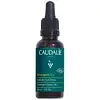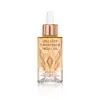What's inside
What's inside
 Key Ingredients
Key Ingredients

 Benefits
Benefits

 Concerns
Concerns

 Ingredients Side-by-side
Ingredients Side-by-side

Caprylic/Capric Triglyceride
MaskingVitis Vinifera Seed Oil
EmollientPrunus Amygdalus Dulcis Oil
Skin ConditioningRosa Canina Fruit Oil
EmollientCitrus Aurantium Amara Leaf/Twig Oil
MaskingLinalool
PerfumingDaucus Carota Sativa Seed Oil
EmollientHelianthus Annuus Seed Oil
EmollientSantalum Album Oil
MaskingTocopherol
AntioxidantCitrus Aurantium Amara Flower Oil
MaskingLavandula Angustifolia Oil
MaskingGeraniol
PerfumingLimonene
PerfumingCitral
PerfumingFarnesol
PerfumingCaprylic/Capric Triglyceride, Vitis Vinifera Seed Oil, Prunus Amygdalus Dulcis Oil, Rosa Canina Fruit Oil, Citrus Aurantium Amara Leaf/Twig Oil, Linalool, Daucus Carota Sativa Seed Oil, Helianthus Annuus Seed Oil, Santalum Album Oil, Tocopherol, Citrus Aurantium Amara Flower Oil, Lavandula Angustifolia Oil, Geraniol, Limonene, Citral, Farnesol
Persea Gratissima Oil
Skin ConditioningOlea Europaea Fruit Oil
MaskingOrbignya Oleifera Seed Oil
EmollientCaprylic/Capric Triglyceride
MaskingSilica Dimethyl Silylate
EmollientHelianthus Annuus Seed Oil
EmollientCocoyl Hydrolyzed Collagen
CleansingOenothera Biennis Oil
EmollientRubus Idaeus Seed Oil
EmollientVaccinium Myrtillus Seed Oil
Skin ConditioningTheobroma Cacao Extract
Skin ConditioningLavandula Angustifolia Oil
MaskingLupinus Albus Seed Extract
Skin ConditioningTocopherol
AntioxidantCitrus Aurantium Amara Flower Oil
MaskingEucalyptus Globulus Leaf Oil
PerfumingMagnolia Officinalis Bark Extract
AntimicrobialRosa Damascena Flower Extract
MaskingRosa Damascena Flower Oil
MaskingLinalool
PerfumingLimonene
PerfumingGeraniol
PerfumingCitronellol
PerfumingFarnesol
PerfumingPersea Gratissima Oil, Olea Europaea Fruit Oil, Orbignya Oleifera Seed Oil, Caprylic/Capric Triglyceride, Silica Dimethyl Silylate, Helianthus Annuus Seed Oil, Cocoyl Hydrolyzed Collagen, Oenothera Biennis Oil, Rubus Idaeus Seed Oil, Vaccinium Myrtillus Seed Oil, Theobroma Cacao Extract, Lavandula Angustifolia Oil, Lupinus Albus Seed Extract, Tocopherol, Citrus Aurantium Amara Flower Oil, Eucalyptus Globulus Leaf Oil, Magnolia Officinalis Bark Extract, Rosa Damascena Flower Extract, Rosa Damascena Flower Oil, Linalool, Limonene, Geraniol, Citronellol, Farnesol
 Reviews
Reviews

Ingredients Explained
These ingredients are found in both products.
Ingredients higher up in an ingredient list are typically present in a larger amount.
This ingredient is an emollient, solvent, and texture enhancer. It is considered a skin-softener by helping the skin prevent moisture loss.
It helps thicken a product's formula and makes it easier to spread by dissolving clumping compounds.
Caprylic Triglyceride is made by combining glycerin with coconut oil, forming a clear liquid.
While there is an assumption Caprylic Triglyceride can clog pores due to it being derived from coconut oil, there is no research supporting this.
Learn more about Caprylic/Capric TriglycerideCitrus Aurantium Amara Flower Oil is the volatile oil obtained from the flowers of the Bitter Orange, Citrus aurantium L. var. amara L., Rutaceae
Farnesol is a compound extracted from essential oils such as lemongrass, rose, and more. It is used as a fragrance in products to help boost floral scents.
Farnesol is a known EU allergen and causes contact dermatitis.
This ingredient is hydrophobic, meaning it is not soluble in water.
Learn more about FarnesolGeraniol is used to add fragrance/parfum to a product. It is the main component of citronellol. It is a monoterpenoid and an alcohol.
Monoterpenes are naturally found in many parts of different plants.
Geraniol can be found in many essential oils including Rose Oil and Citronella Oil. The scent of Geraniol is often described as "rose-like". Many foods also contain Geraniol for fruit flavoring.
Geraniol can irritate the skin when exposed to air. However, irritation depends on the ability of geraniol to penetrate into the skin. In general, geraniol is not able to penetrate skin easily.
Geraniol is colorless and has low water-solubility. However, it is soluble in common organic solvents.
Like citronellol, it is a natural insect repellent.
2,6-Octadien-1-ol, 3,7-dimethyl-, (2E)-
Learn more about GeraniolHelianthus Annuus Seed Oil is the oil derived from the seeds of a Sunflower. Sunflower seed oil is non-fragrant. It is an emollient, meaning it helps to soften the skin.
Sunflower seed oil contains many fatty acids. The fatty acids found in sunflower seeds include (from highest amount to least): linoleic acid, myristic acid, palmitic acid, stearic acid, arachidic acid, oleic acid, and linolenic acid.
These fatty acids help the skin create ceramides. Ceramides play a role in repairing the skin barrier.
Helianthus Annuus Seed Oil helps moisturize the skin. This in turn helps the skin look more rejuvenated and smoother.
Sunflowers are rich in vitamin E.
Historians believe Indigenous cultures of North America domesticated sunflowers before corn. Thus they relied on sunflower oil for a variety of uses. One such use is moisturizing skin and hair.
Sunflower seed oil may not be fungal acne safe. We recommend speaking with a professional if you have any concerns.
Learn more about Helianthus Annuus Seed OilLavandula Angustifolia Oil is more commonly known as lavender essential oil. It is considered a fragrancing ingredient.
Lavender imparts a famous scent. While the smell is lovely, this ingredient and may sensitize skin in topical products. This is because about 85% of the oil is made up of linalool and linalyl acetate.
When exposed to air, these two compounds become strong allergens. This ingredient exhibits cytotoxicity at low concentrations; amounts of 0.25% have been shown to damage skin cells.
A study from Japan found this ingredient caused lavender sensitivity after widespread exposure.
Lavender essential oil has some antimicrobial, antibacterial, and anti-inflammatory properties. However, the cons of this ingredient may outweight the pros.
More research is needed to confirm lavender essential oil's effects when used in aromatherapy.
Lavandula Angustifolia is known as the English Lavender and famous for creating purple fields in Provence, France.
Learn more about Lavandula Angustifolia OilLimonene is a fragrance that adds scent and taste to a formulation.
It's found in the peel oil of citrus fruits and other plants such as lavender and eucalyptus. The scent of limonene is generally described as "sweet citrus".
Limonene acts as an antioxidant, meaning it helps neutralize free radicals.
When exposed to air, oxidized limonene may sensitize the skin. Because of this, limonene is often avoided by people with sensitive skin.
The term 'fragrance' is not regulated in many countries. In many cases, it is up to the brand to define this term. For instance, many brands choose to label themselves as "fragrance-free" because they are not using synthetic fragrances. However, their products may still contain ingredients such as essential oils that are considered a fragrance.
Learn more about LimoneneLinalool is a fragrance and helps add scent to products. It's derived from common plants such as cinnamon, mint, citrus, and lavender.
Like Limonene, this ingredient oxidizes when exposed to air. Oxidized linalool can cause allergies and skin sensitivity.
This ingredient has a scent that is floral, spicy tropical, and citrus-like.
Learn more about LinaloolTocopherol (also known as Vitamin E) is a common antioxidant used to help protect the skin from free-radicals and strengthen the skin barrier. It's also fat soluble - this means our skin is great at absorbing it.
Vitamin E also helps keep your natural skin lipids healthy. Your lipid skin barrier naturally consists of lipids, ceramides, and fatty acids. Vitamin E offers extra protection for your skin’s lipid barrier, keeping your skin healthy and nourished.
Another benefit is a bit of UV protection. Vitamin E helps reduce the damage caused by UVB rays. (It should not replace your sunscreen). Combining it with Vitamin C can decrease sunburned cells and hyperpigmentation after UV exposure.
You might have noticed Vitamin E + C often paired together. This is because it is great at stabilizing Vitamin C. Using the two together helps increase the effectiveness of both ingredients.
There are often claims that Vitamin E can reduce/prevent scarring, but these claims haven't been confirmed by scientific research.
Learn more about Tocopherol